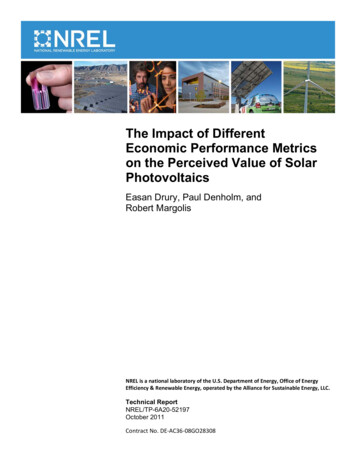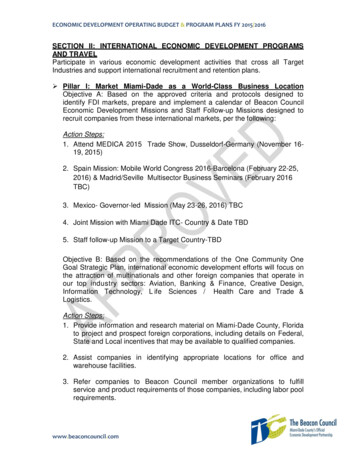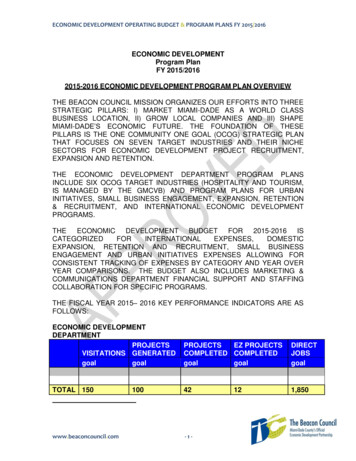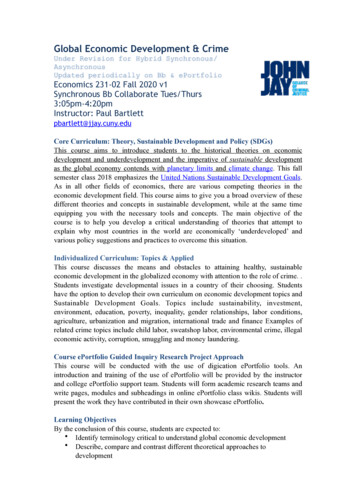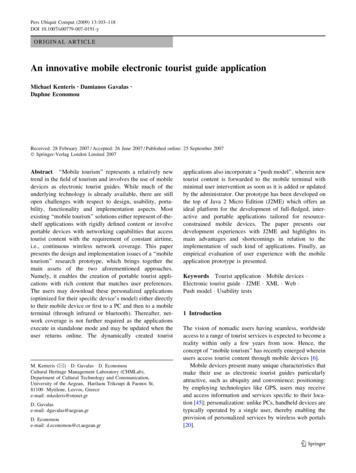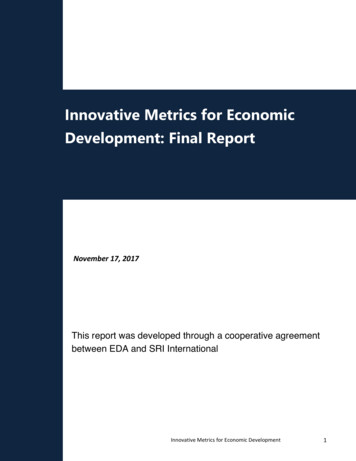
Transcription
Innovative Metrics for EconomicDevelopment: Final ReportMarch 1, 2016November 17, 2017This report was developed through a cooperative agreementbetween EDA and SRI InternationalInnovative Metrics for Economic Development1
AcknowledgementsThis project was funded by a grant from the U.S. Department of Commerce, Economic Development Administration(EDA). Special thanks to EDA headquarters staff that contributed to the project: Ksenia ShadrinaBryan BorlikRyan SmithEric SmithThe Center for Innovation Strategy and Policy at SRI International conducted this research. Report authors and keycontributors include Roland Stephen, Laura Ross, and Nikhil Kalathil.The findings and observations contained in this report are those of the authors and do not necessarily reflect theviews of any particular interviewee or of the Economic Development Administration in general.Innovative Metrics for Economic Development2
Table of ContentsTable of Tables. 4Table of Figures . 5Project Highlights . 6Executive Summary . 7Project Overview . 8Logic Model . 10Establishing the Logic Model for Evaluation of Non-Infrastructure Economic Development Programs . 10Using an Econometric Model in Conjunction with the Logic Model. 12Econometric Model. 14Methodological Approach. 14Explaining Long-Term Economic Performance . 14Research on Long-Term Economic Performance . 15Model Design . 16Variables . 17Control Variables . 17Capacity Variables . 18Data Limitations. 22Capacity Variable Analysis and Results . 23Detailed Discussion of Results . 24Summary of Results from Capacity Analysis. 25Differentiating Capacity Variables: Economic Drivers and Networking Capacity . 29Summary of Networking Capacity Analysis . 31Program Level Impacts: Collecting and Assessing Data . 34Pilot Survey and Results. 36Conclusions . 38Appendix A: Summary Statistics . 40Appendix B: Robustness Checks . 43Appendix C: Selected Literature . 50Literature for Capacity Outcomes. 50Literature for Realized Outcomes. 51Appendix D: Survey Results . 52Appendix E: Cited References . 59Appendix F: Survey Challenges and Lessons Learned for EDA . 61Survey Fatigue . 61Difficulty Reaching Clients . 61Innovative Metrics for Economic Development3
Table of TablesBackground . 10Research on Capacity Outcomes . 11Table 1: Normalized variable abbreviations and descriptions . 23Table 2: Identified relationships, combined metropolitan and micropolitan regions . 26Table 3: Identified relationships, metropolitan regions only . 26Table 4: Identified relationships, micropolitan regions only . 27Table 5: Capacity indicators on outcome variables . 28Table 6: Capacity indicators on outcome variables with networking capacity analysis . 33Table 7: Summary of survey recipients and respondents . 36Table 8: Selected summary statistics from grantee program outputs survey . 37Table 9: Average client rating of improvement due to grantee support and services . 37Table 10: Selected summary statistics of client capacity outcomes . 37Table A- 1: All regions . 40Table A- 2: Metropolitan regions . 41Table A- 3: Micropolitan regions . 42Table B- 1: Correlation matrix of normalized capacity variables . 43Table B- 2: Correlation matrix of non-normalized capacity variables. 44Table B- 3: Non-normalized capacity indicators on outcome variables . 45Table B- 4: Networking capacity and capacity variable interaction on long-term earningsgrowth tests . 47Table B- 5: Capacity variables on earnings growth with different definitions of thenetworking variable . 49Table D- 1: Summarized results from the i6 grantee program outputs survey . 52Table D- 2: Summarized results from the i6 client capacity outcomes survey . 54Table D- 3: Average amount of funding obtained by i6 clients, by source. 55Table D- 4: Summarized results from the SFS grantee program outputs survey . 56Table D- 5: Average amount of funding obtained by SFS grantee clients, by source . 57Table D- 6: Summary of combined SFS and i6 program output survey responses . 58Innovative Metrics for Economic Development4
Table of FiguresFigure 1: Logic model for non-infrastructure economic development programs . 12Figure 2: Econometric study for non-infrastructure programs . 13Figure 3: Capacity variables . 19Figure 4: Project components . 34Figure 5: Economic development program logic model . 35Figure 6: Overview of survey flow. 36Figure 7: Dual-level approach to assessing impacts . 38Innovative Metrics for Economic Development5
Project HighlightsStudy OverviewSRI International’s Center for InnovationStrategy and Policy conducted this study incoordination with EDA. The project consists of: The development of metrics to assessimpact of economic developmentprograms on capacity building and longterm economic performance as part of anew program evaluation system. Acorresponding toolkit for implementationof the system, including a surveyinstrument, has also been developed. An econometric model to demonstrate theimpact of non-infrastructure grantprograms on regional economic capacities,and the relationship between thosecapacities and long-term realized outcomessuch as job creation and per capita orearnings growth. A pilot of the survey instrument to directlycollect data from a subset of EDA’s noninfrastructure grantees.While the project is modeled around EDAprograms and uses EDA-specific data in itsanalyses, the work is intended to inform abroader body of work on program evaluation ineconomic development.As a whole, the project suggests that noninfrastructure grant programs, such as thoseadministered by EDA, build economicdevelopment capacities and estimates thedegree to which these capacities have animpact on long-term economic performancesuch as employment and income. The studyalso reveals differences in impact ofeconomic development interventionsdepending on whether they occur inmetropolitan or micropolitan areas in theUnited States.Capacity Variables and Economic PerformanceThrough regression analysis, SRI found the following relationships: Increases in financing events are correlated with higher rates ofboth earnings and employment growth. Larger numbers of membership associations and organizationsand a higher creative class share of the workforce are correlatedwith higher rates of earnings growth.hmok Higher rates of establishment churn are associated with higheremployment growth, but reduced levels of earnings growth. Tech intensive non-employer firms (or small enterprises) tend tocontribute to employment growth, as well as per capita incomegrowth.EDA Grants as a Facilitator of Networking CapacityAfter creating a combined variable that captures the interaction of regionalorganizations and EDA activity, SRI found the following through additionalregression analysis at a regional level: EDA activity and organizational density impact economicperformance for micropolitan regions. Networking capacity is important in micropolitan regions, andrelies heavily on the presence of EDA grants. This supports thehypothesis that institutional capacity and networks inmicropolitan regions is an important indicator of future economicperformance.Grantee and Client SurveySRI piloted the survey instrument to collect data from EDA’s RegionalInnovation Strategies (RIS) grantees and their clients from 2014 and 2015: Respondent grantees in the RIS program served over 3,600 clientsthrough their EDA grants. 56 respondent clients reported increasing the TRL of a product orproducts through services supported by EDA grants, with anaverage TRL increase of 3.39. 88 respondent clients accessed venture capital, seed, and/orangel funding through the services supported by the EDA grant. The results from the pilot, albeit limited in sample size, indicate alink between EDA non-infrastructure programs and developmentof capacities integral to long term economic outcomes.Innovative Metrics for Economic Development6
Executive SummaryThis project represents a major step forward in the assessment of non-infrastructure economic developmentinitiatives towards a broad, generalizable approach to data collection and analysis. The assessment is grounded ina comprehensive logic model that captures the progression of a grant program from inputs, to activities, to bothshort-term and long-term outcomes. As a definitional matter, in this report and analysis, when we refer toperformance measurement or program evaluation, we refer to monitoring the performance of or evaluation ofeconomic development programs, respectively.To monitor short-term impacts at the program level, SRI developed flexible survey instruments for data collectionfrom both, grantee organizations and their clients, and piloted the instruments using a set of EDA grantees from2014-2015. 1 The results of this pilot were used to both assess the impact of EDA programs on grantee capacities,as well as to refine and improve the survey instruments themselves. Ultimately, these instruments aim to helpeconomic development practitioners to monitor the activities performed by grantees as well as to evaluate theimpact of these activities on the building or improving of capacities that businesses and communities need tosucceed.To evaluate long-term impacts of economic development programs at the regional level, SRI developed aneconometric model based on measures of economic development capacity. SRI identified a set of measures at thelevel of metropolitan or micropolitan geographic regions that serve as reliable proxies for the aggregate capacitiesdeveloped through economic development programs. SRI’s regression analysis based on those measures capturesthe relationships between economic development grant activity and long-term economic growth and development.SRI conducted quantitative analysis to ascertain the validity of the proposed metrics and the logic model throughtwo econometric methodologies. The first was a regression of capacity measures on long-term economicperformance with appropriate controls. In the second model, SRI separated out three variables that represent aregion’s networking capacity to support economic development. In this study, networking capacity is calculated byinteraction of the number of economic development organizations, the number of EDA non-infrastructure grantsreceived, and the number of membership associations and organizations in a region.The results from SRI’s regression analysis elucidate the pathways through which non-infrastructure economicdevelopment programs indirectly influence long-term economic performance. One intriguing result is an observeddifference between metropolitan and micropolitan regions when it comes to the importance of networkingcapacity. Stronger networking capacity appears to have a greater impact on smaller regions with limitedinstitutional capacity. An understanding of these differences can be used to guide economic developmentinvestment and policy decisions to ensure a strategic place-based implementation conducive to a more inclusiveeconomic development and growth process.Specifically, SRI piloted the survey instruments among the 2014 and 2015 recipients of the i6 Challenge program and the Seed FundSupport program.1Innovative Metrics for Economic Development7
Project OverviewThe U.S. Department of Commerce’s Economic Development Administration (EDA) is the only federal governmentagency focused exclusively on economic development. Economic development:“Creates the conditions for economic growth and improved quality of life by expanding the capacity ofindividuals, firms, and communities to maximize the use of their talents and skills to support innovation,lower transaction costs, and responsibly produce and trade valuable goods and services."A key component of this economic development capacity is effective, collaborative institutions focused onadvancing mutual gain for the public and private sectors.EDA has a broad portfolio of non-infrastructure grant programs that support start-ups, small firm development,technology development, regional innovation ecosystems, workforce development, planning activities, andresearch. These economic development and innovation-focused programs yield improved capabilities forparticipants, which include entrepreneurs, small businesses, and regional organizations. These programs also havelong-term, broader economic benefits, such as increased earnings and job growth. These benefits can be difficultto capture in the short term or as part of a single assessment. Yet, in difficult economic times and in an environmentof increasing support for evidence-based policymaking, it is important to develop tools that allow policymakers toforecast the future economic benefits of programs and policies.Economic development programs are difficult to evaluate due to the temporal and analytical distance betweenfocused program activities and desired long-term economic performance. An additional challenge is theidentification of valid indicators for complex programs that fuel economic development capacity-building. Whilestandard approaches to program evaluation focus on long-term economic indicators such as company or jobcreation, this project demonstrates connections between program activities and shorter-term or capacity outcomeswhich, as supported by a broad body of research as well as this study, are integral to longer-term desirable economicoutcomes.SRI International was awarded a grant by EDA to formulate an approach that would capture the impact of noninfrastructure economic development investments on long-term realized outcomes. The approach adoptedelaborates a carefully refined logic model, suitable for general application to any similar program. The model isgrounded in the deep experience of the project team, in the relevant literature, and in the counsel and guidance ofEDA staff. The model defines categories of economic development capacity targeted by such programs. Thesecategories map to capacities and are best characterized as short-term effects or outcomes. While, as part of thisproject, SRI proposes that capacity outcomes can and should be measured at the program level through directcollection of data, these outcomes should also be ascertained in terms of a regional impact where the program isadministered. Therefore, in order to estimate the long-term impact of these capacities, the project team establisheda set of indicators as proxies for the categories of capacities. These indicators, although refined throughout theanalysis, originate in the earlier research conducted by SRI in collaboration with other distinguished institutions(UNC Chapel Hill, GWU, etc). 2 The team compiled a dataset containing these indicators for all metropolitan andmicropolitan regions of the United States. In addition to the capacity measures, the dataset includes outcome2The reports detailing this work can be found on: tive Metrics for Economic Development8
indicators (earnings, employment, and personal income) and standard social and economic control variables. Theteam then employed a variety of econometric analyses designed to sift the relationships between capacities andlong-term economic performance. The findings are reported below.In summary, this project developed a logic model for capturing the impact of economic development programs oneconomic development capacity, and then tested aggregate measures of those capacities against long-termeconomic performance. This project also developed a comprehensive toolkit for the direct collection of programdata. The operational toolkit comprises a survey instrument and a protocol for the use of economic developmentpractitioners. The toolkit and all accompanying instruments have been carefully designed to meet the needs of anynon-infrastructure economic development program. The instrument was piloted among recipients of grants fromthe 2014 and 2015 Regional Innovation Strategies competitions. The results reported in Section III of this reportindicate in a straightforward but important way that the program is generating the outputs expected of it.Innovative Metrics for Economic Development9
Logic ModelEstablishing the Logic Model for Evaluation of Non-Infrastructure Economic Development ProgramsFor most economic development programs, it is challenging to establish direct, causal relationships betweenprogram activities and long-term outcomes. Logic models help to address this challenge by establishing theoretical“if-then” relationships across a program’s activities, outputs, and immediate outcomes. As such, they are usefultools for structuring program evaluations, helping account for immediate, measurable impacts that stem from aprogram’s activities, while logically relating these outputs to longer-term quantitative outcomes.To review, the logic model captures the logical progression of a grant program, from inputs to activities toimmediate outcomes. Within each component of the logic model, different categories of inputs, outputs, andoutcomes might occur depending on the program’s focus. For example, a program’s “outputs” or activities mightfocus on events, networking, and referrals; or some other area(s) as illustrated in the logic model presented inFigure 1 below.The specific components of the logic model are defined as follows: Initial Conditions & Capacities: The “baseline” or underlying factors and externalities that affect the programand its participants, and that may shape the types and magnitude of outcomes achieved. Inputs: The investments in the program, which may include financial resources (e.g., grants), as well asintangible resources such as staff expertise, space, or other factors. Outputs (Program Activities): A measurement of the quantity and quality of the activities performed by theprogram grantees, partners, and clients or participants. Capacity Outcomes: The direct, shorter-term outcomes that occur as a result of the program that enhance thecapabilities of the program’s clients or participants. Realized Outcomes: The broader long-term impacts of a program, including at a regional level, which mayinclude measurable growth in terms of jobs or other quantifiable economic indicators.The logic model as illustrated below grounded in several years of cooperative research by SRI, EDA, and otherinstitutions. This work both, furthered SRI’s understanding of EDA’s programs and helped define a generalframework for economic development initiatives, more broadly. The components of the logic model, as delineatedin this research, draw from a vast body of work on economic development theory and praxis. The literature on theinputs, activities, and outputs of programs that build capacity, and on the impact of those capacities on long-termoutcomes such as earnings and employment is quite expansive.BackgroundThere is an expansive body of work on program evaluation that focuses on program inputs, outputs, and near-termcapacity outcomes. This literature tends to be focused on individual and program level activities, as exemplified byassessments of incubator and accelerators as well as broader programs targeting innovation through investment ininstitutions and networks. While this literature often seeks to identify longer-term impacts, these prove hard toestimate due to limitations of the data and underlying attribution problems. The data in these studies are almostalways directly collected or self-reported and rely heavily on survey results.Innovative Metrics for Economic Development10
There is a separate (if logically connected) literature on economic development that focuses on the relationshipsbetween near-term capacity outcomes and long-term realized outcomes. This literature is focused on the sector orregional level, and is exemplified by econometric studies that suggest the importance of key cluster or regionalcapacities—such as a skilled workforce or risk capital—for long-term outcomes such as employment, income, andinvestment. In this literature, the details of policies that shape workforce or finance are not usually addressed, buttheir relative importance for outcomes are estimated, based on third party indicators.The methodological design of this project is grounded in both bodies of work. The first grouping of literature offersanalyses of impact, performance, and best practices for specific programs. The second presents evidence for theimpact of specific capacities on long-term economic development outcomes. As discussed below, this literature hasconvincingly shown and empirically demonstrated the importance of capacities—for example, human capital—indetermining long-term outcomes such as income and employment. However, as also discussed below, there aregaps in this literature, and the purpose of the econometric work that lies at the heart of this study was to fill a selectnumber of these gaps.The findings from literature were an important input guiding SRI’s selection of data collection requirements at theprogram level as well as of the kinds of third party indicators at the regional and aggregate levels. Taken together,the components and variables developed, based in part on established findings, were tested to validate a carefullyselected set of program metrics and demonstrate their importance for the long-term outcomes (a selectedbibliography for these literatures is provided in Appendix C).Research on Capacity OutcomesOne of the primary goals of this project was the development of general purpose metrics for non-infrastructureprograms, insofar as it is practicable. However, from the beginning it has been recognized that some programs arehome to highly specialized activities, in particular programs that support a similar population of grantees, such asincubators and accelerators. In these cases, the importance of specific institutional variables can be disentangled inways that are not possible for programs with more heterogeneous populations of grantees. For example,evaluations of incubators, which have been extensively investigated, have often discovered that key institutionalattributes of an incubator, such as for-profit versus non-profit status, governance, partnerships, funding mix, size,etc., are predictors of success. 3 Thus, an analytical framework that captures these attributes is very important. Thegoal in this project, however, was to build a framework that can encompass a broader range of programs. As such,the framework described below seeks to capture the specific institutional variables that have been previouslyidentified as significant, while simultaneously accounting for generic variables applicable to a heterogeneouspopulation of grantees.Program evaluations tend to investigate the institutional attributes that result in desirable outputs and outcomesto inform future programs. However, there is wide variation in institutional characteristics across granteeorganizations. For example, the i6 program run by EDA has supported grantees that have included a single, freestanding non-profit, a program administered by a partnership between two regional research institutions, and anetwork of institutions addressing clean tech needs of a multi-state region. This heterogeneity reflects theimportance of the “bottom-up” identification of economic opportunity, and emphasizes the fact that economicdevelopment organizations tend to inv
Economic development programs are difficult to evaluate due to the temporal and analytical distance between focused program activities and desired term economic performance. An additional challenge is the long-identification of valid indicators for complex programs that fuel
